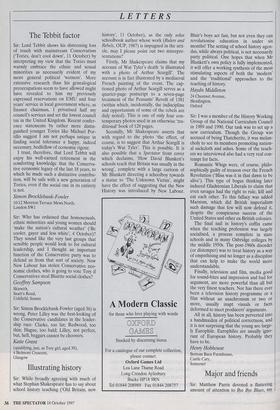Illustrating history
Sir: While broadly agreeing with much of what Stephan Shakespeare has to say about school history teaching ('Old Britain, new history', 11 October), as the only so/us schoolbook author whose work (Rulers and Rebels, OUP, 1987) is impugned in the arti- cle, may I please point out two misrepre- sentations?
Firstly, Mr Shakespeare claims that my account of Wat Tyler's death `is illustrated with a photo of Arthur Scargill'. The account is in fact illustrated by a mediaeval French painting of the event. The cap- tioned photo of Arthur Scargill serves as a quarter-page postscript to a seven-page treatment of the Peasants' Revolt of 1381 (within which, incidentally, the indiscipline and opportunism of some of the rebels are duly noted). This is one of only four con- temporary photos used in an otherwise `tra- ditional' book of 128 pages.
Secondly, Mr Shakespeare asserts that with regard to the photo `the effect, of course, is to suggest that Arthur Scargill is today's Wat Tyler'. This is possible. It is also possible that a Spectator front cover which declaims, 'How David Blunkett's schools teach that Britain was usually in the wrong', complete with a large cartoon of Mr Blunkett directing a schoolboy tgwards a statue to `The Unknown Victim', might have the effect of suggesting that the New History was introduced by New Labour. Blair's boys act fast, but not even they can revolutionise education in under six months! The setting of school history agen- das, while always political, is not necessarily party political. One hopes that when Mr Blunkett's own policy is fully implemented, it will offer a working synthesis of the most stimulating aspects of both the `modern' and the `traditional' approaches to the teaching of history.
Haydn Middleton
24 Chestnut Avenue, Headington, Oxford


























































































 Previous page
Previous page